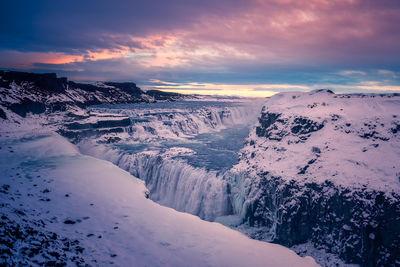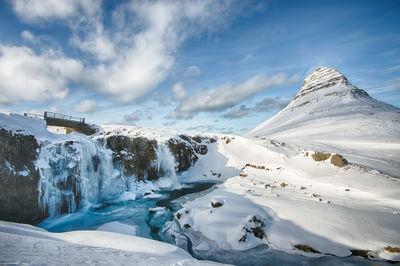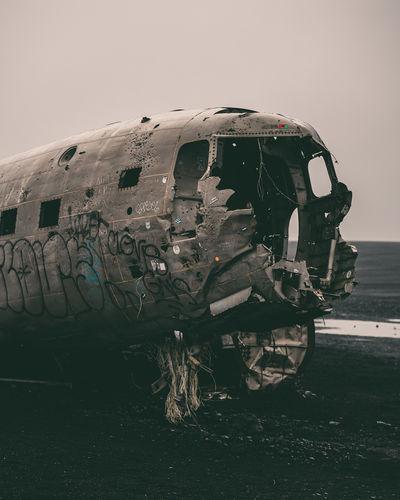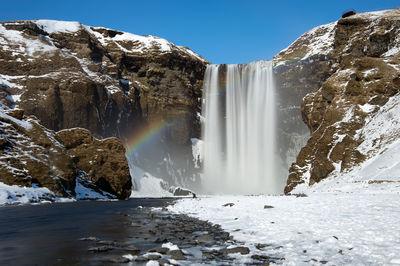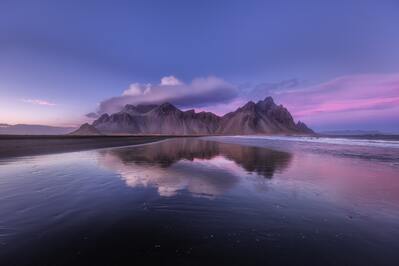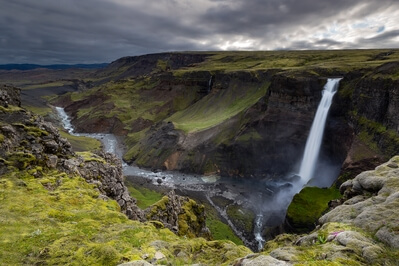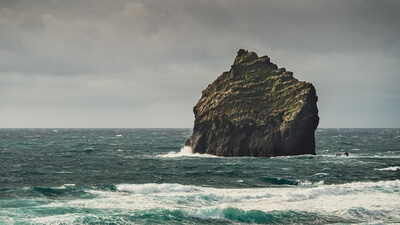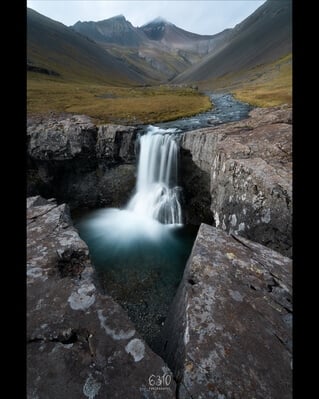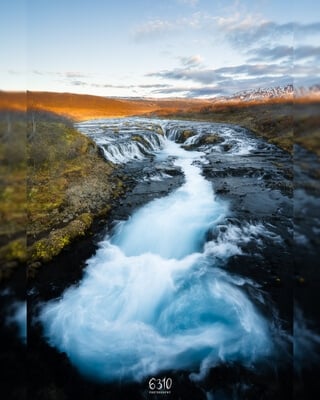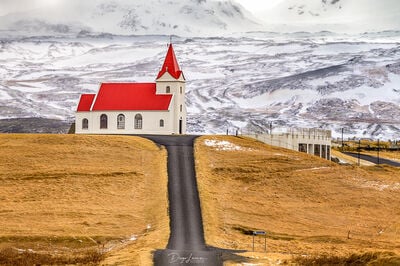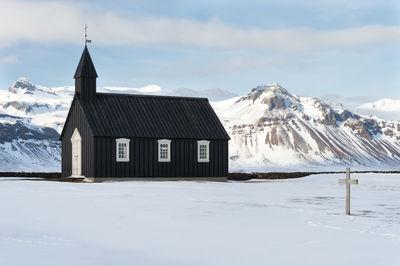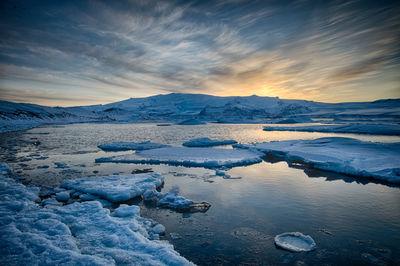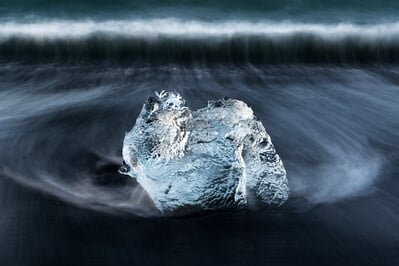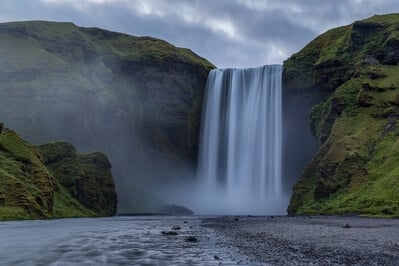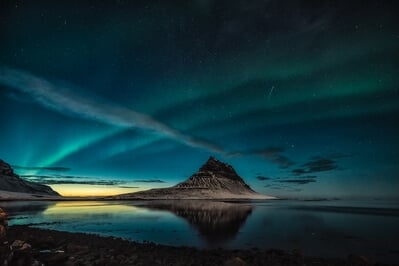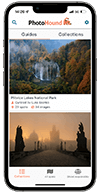The international airport is in Keflavik about an hours drive south west of Reykjavik. If going on a self drive tour (most flexible option – but see further details below regarding driving in Iceland) there are plenty of places to hire cars at the airport from well-known international operators to local firms.
It is possible to travel around Iceland using public transport (buses – there are no public trains on the Island). There are regular bus services from the airport into Reykjavik, and from Reykjavik it is possible to get buses to all over the island.
Many people choose to explore the island on some form of guided tour, be that a fully organised one for the whole duration of a trip, or through taking day trips from Reykjavik. There are many firms and individuals that run photography tours of the island, and if you don’t want to self drive these can be a good option, in particular as they are tailored with photography in mind.
Driving in Iceland
The most flexible way of photographing Iceland is to hire a car (you must be 20, or 23 for a 4x4 car) and held a licence for at least a year. This allows you to set your own itinerary and visit locations when the light is at its best. Many people assume that to drive around Iceland you need a 4x4. Whilst 4x4’s can be useful, they are not essential, unless you plan to drive into the mountain “F-roads”, gravel roads of varying states of repair which are open in the summer months, in which case 4x4’s are mandatory.
All of the car hire companies will offer different levels of “accidental damage” insurance. It is worth making sure you are clear what is and isn’t covered and what you are getting for any extra premium, and research what kind of cover you are likely to need. For example, if visiting the south coast in particular, it is probably advisable to get “sand and ash” cover. This will cover you for any damage to the car caused by sand and ash particles blown onto the car from the very high winds that can blow across the island (see below for more on weather) – sand and ash storms can literally strip the paint from a car. It is also advisable to be careful when opening car doors in high winds as it has been known for doors to be ripped off cars and most accidental damage policies won’t cover this.
Route 1, or the “Ring Road” runs 825 miles around the entire island starting and ending in Reykjavik. A lot of the photographic spots can be found on, or a short drive from, this road. Route 1 is a good road which is now nearly all tarmacked, but many of the smaller roads, and the roads off route 1 in the far east, north and west of the country, are gravel. Many of Iceland’s smaller roads, and part of the ring road, are narrow and contain narrow single lane bridges. The car that is closest to the bridge has the right of way.
In the winter months, from October through to April, when the snow starts to fall and the roads start to ice up, driving in Iceland can be a challenge. Whilst the Icelandic are very good at getting the main roads ploughed, many of the smaller roads may not be cleared as regularly, and after heavy or prolonged periods of snow even the main roads will not be completely free of snow. There are many sites on the internet that can provide detailed advice on driving in Iceland in the winter, and it is worth reading a selection of these if you are considering visiting during the winter months. If you are careful, drive slowly, give yourself plenty of time to reach a destination and make sure you check the road and weather conditions before driving (always visit the road.is website before heading out on a journey), then everything should be fine. If you get caught in high wind or poor visibility, then pull over safely onto the side of the road and wait it out. And be flexible with your plans, if you are travelling a particular distance from Reykjavik then it maybe that you can’t reach your intended destination.
Weather
Despite its name Iceland is not actually that cold, given its latitude. This is because it benefits from the gulf stream bringing warmer air from the south. In the winter months the average temperature is just below freezing in the south of the Island, although in the north temperatures can drop to as low as minus 25 degrees, colder in the wind. In the summer the average temperature is 12-13 degrees but can reach as high as mid-twenties centigrade.
From October to April much of the country will be covered in snow, in particular the further north you get, and the mountain F-roads will be closed. From May, as the temperatures start to warm, the snow in the exterior of the country will disappear, but the highlands will often remain inaccessibly until mid to late June, and patches of snow will often persist here well into the summer months.
The wind on Iceland can get very fierce. Whilst the average wind speed is around 10-15mph, in stormy weather winds can reach up to 40-50mph with gusts much higher. As a lot of Iceland is an open landscape there can often be little shelter from the winds.
Whatever you are looking to do in Iceland it is always a good idea to check the weather forecast so you know what to expect during the day and whether you need to change your plans.
Reykjavik
Reykjavik is the capital of Iceland and home to over half the population of the country. It is a great place to base yourself for a trip to the Island (day trips are possible to many of the great photographic spots from here) and well worth spending a couple of days exploring itself.
Photographically the capital has a lot to offer, from the Sun Voyager statute on the waterfront that is a great location for both sunrise and sunset shoots, the Harpa Concert Hall which has the most amazing and interesting glass façade, and the impressive Hallgrímskirkja cathedral.
There are also many spots close to Reykjavik that are good places to see the Northern Lights, in particular the Grotta Island lighthouse a few miles to the west of the city centre, Kleifarvatn lake about a 40 minute drive south of the city and Thingvellir National Park about an hour east of the city.
Snaefellsness peninsula
Located 150 miles to the north west of Reykjavik lies the Snaefellsness peninsula which sits in the shadow of the Snaefellsjokull volcano. There are many areas here for the photographer to visit and I would recommend spending two to three days in the area.
Highlights include the black church and dunes at Budir (the church is often used as a foreground for aurora shots), the sea arch at Anastapi and stacks of Londranger, and of course Kirkjufell which rises majestically out of the sea at Grundarfjordur and which provides the perfect backdrop to the waterfalls of Kirkjufellfoss.
This area is good to visit in both summer and winter. In winter the main roads are generally fairly well ploughed including the Utnesvegur road that runs around the edge of the peninsula from Budir to Olafsvik. The route 54 road, which runs over a pass to the east of the volcano, may be hard to cross in this section after heavy snow and before it has been ploughed.
Golden Circle
The golden circle is made up of three areas each within a 2 hour drive of Reykjavik:
- Thingvellir National Park
- Geysir Geothermal Area
- Gullfoss Waterfall
Many guided tours run from Reykjavik but the most flexible option, for a photographer, is to hire a car and explore the sights at your own pace and own time.
South Coast
The south coast of Iceland is home to many great photographic spots and it is worth spending four or five days along here, with maybe a couple of days based near Vik and a couple of days based further east near Jokulsarlon. It is also possible to visit some of the more westerly locations on a day trip from Reykjavik.
Main highlights worth visiting in the area are:
- Skogafoss and Seljalandsfoss waterfalls
- Solheimasandur plane wreck
- The town of Vik and the nearby Reynisjara beach
- Fjadrargljufur Canyon
- Jokulsarlon glacial lagoon and “ice beach”
The beach and dunes at Stokksnes with the views to the Vestrahorn mountains rising out of the sea
Thórsmörk, at the end of the Laugevagur trail, is also a short drive off the ring road, and can provide a taste of the highlands, especially if you hike to the top of Valahnukur.
Highlands
The Highlands, in the interior of the country, are an expansive area of mountains, volcanoes, lava fields, lakes, rivers and expanses of black sand desserts, and are a must visit for any photographer who loves mountain photography. To say the shots you will get from here can be unique is an understatement.
The most easily accessible part of the highlands is the area between Thórsmörk and Landmannalauger, between which runs the Laugavegur trail. Both Thórsmörk and Landmannalauger are accessible by bus, which is probably the most sensible way to reach these destinations, certainly Landmannalauger which lies deep in the highlands (Thórsmörk which is close to the south coast is more easily accessible). Whilst it is possible to drive 4x4 hire cars into the highlands it is not recommended unless you are a skilled and confident off-road driver.
The Laugavegur trail is a 55km walk that runs through the most amazing and varied scenery, from the Rhyolite hills surrounding Landmannalauger, to the green mountains and black sand expanses near Alftavatn, and lush green woods around Thórsmörk. Most people and tours will do the trail over 4 days, but if photography is your main aim I would suggest taking 5 or 6 days to walk the trail, keeping the time on the trail short, and allowing plenty of time to explore the area where you camp. There are 6 official campsites along the trail at Landmannalauger, Hrafntinnusker (can be very windy), Alftavatn, Hvanngil (not far from Alftavatn), Emstrur and Thórsmörk. If you wanted to spend a couple of days in the same area as part of the trip then I would recommend doing this at Landmannalauger, Alftavatn or Hvanngil.
As the mountain F roads are shut during the winter, which in years where the snow fall has been extensive can reach into May/June, it is best to plan on taking a trip to the Highlands in July to September.
Northern Lights
Many people travel to Iceland in the winter to see the magic of the northern lights. If you are lucky, and conditions allow, you could be rewarded with an amazing multi-coloured light display. However, many factors need to come together to realise this dream (clear nights and sufficient solar activity being the main ones) so it is best to go with low expectations. Even on clear nights when there is solar activity the display maybe weak, barely visible to the naked eye. There are a few websites that predict solar activity
Photographing the northern lights is much like other astrophotography. You will need the widest aperture lens you own, ideally an F2.8, set at that aperture, probably focused at or close to infinity, with a long shutter speed, typically 10-30 seconds depending on the ISO at which you set your camera (try 1600 to start with) and the intensity of the display.
As with any other photograph you need a compelling composition to make an interesting photograph, so plan to be at a location that will provide this. Lakes, where there is potential for the lights to be reflected in the water, are often good locations, as are locations where you can place a strong foreground objective in the frame, such as the Black Church at Budir, and those with a strong background such as Kirkjufell or the Vestrahorn mountains at Stokksnes.
